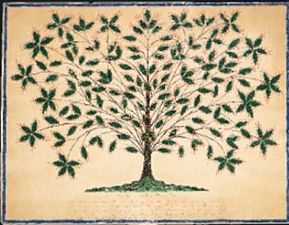Union Village Shaker settlement

 |
| Topics |
|---|
|
| Notable people |
|
The Union Village Shaker settlement was a village organized by Shakers in Turtlecreek Township, Warren County, Ohio.
Shaker settlement
The Union Village Shaker settlement was a community of Shakers[1][2] founded in 1805.[3] It was the bishopric, or governing unit, from 1805 to 1910 for other Shaker villages, including the Whitewater Shaker Settlement and the Watervliet Shaker Village in Ohio. After 1862, North Union fell under Union Village. After 1889, Union Village oversaw all societies in Kentucky and Ohio.[1]
It had once been one of the largest Shaker settlements, but by the 1830s there was a significant reduction in adult members,[4] which was exacerbated in 1838 and 1839 when there was strife among the sect members over ideological differences and accusations during the early years of the Era of Manifestations.[5]
Elder Oliver began publishing spiritual works and poetry about the Shaker sect to attract people to the sect.[6]
By the 1870s the community did not have sufficient "believers" to work to support the village. They became increasingly in debt into the 1880s. About 1882 James Fennessey joined the community and soon implemented a plan to rent out land to farmers to create a revenue stream. In 1892 North Union site was sold for $316,000 which was intended to pay off the debts incurred during the previous two decades. The money was mismanaged, though, by Joseph Slingerland. He spent about $500,000 on property purchases, improvements, and renovations. The Watervliet site was mortgaged to compensate for the expenditures and debt. Fennessey became a trustee and by 1902 had Slingerland removed from the ministry and filed suit against him and an elderess. By 1908 the ministry was free of debts.[7]
In 1898 they attempted to create a settlement in Georgia at White Oak,[8] by Elder Oliver who died while on a visit to create momentum for the flagging endeavor. With his death came the end to the creation of the settlement at White Oak.[6]
Hundreds joined the Shakers, who believed that Christ had already appeared for the second time in the person of Mother Ann Lee. The "Advents'" impact was greatest on the Shaker villages at Union Village and Whitewater, Ohio, Harvard, Massachusetts, and Canterbury, New Hampshire. Some remained Shakers for the rest of their lives; others left after a short time.[9]
Wisdom's Paradise
In December 2004, United States Senator from Ohio, Rob Portman, and Cheryl Bauer published a book on the 19th century Shaker community at Union Village. The book was titled Wisdom's Paradise: The Forgotten Shakers of Union Village. At the end of the twelfth chapter, "An Eternal Sabbath, A Restless Peace," Portman summarizes the dual aspects of Shaker impacts at the close of their way of life at Union Village as both warming to mainstream worldly culture and detrimental to long established order:
Intentionally or unintentionally, the Believers were influencing society in many ways. Little by little, they were becoming more similar to their neighbors. The trend made them more acceptable to society, but in retrospect may have contributed to their demise in Warren County. In economic affairs, they increasingly adapted the methods of the world: taking out loans, using mass marketing techniques. Those strategies sometimes compromised inherent Shaker principles of self-sufficiency and modesty. The Believers were no longer the radical group that attracted people who hungered for a different kind of faith; they were becoming a part of mainstream society.[10]
Correctional Institutions
The Lebanon Correctional Institution and the Warren Correctional Institution, which are adjacent to one another, were built upon land that had been part of the settlement.
References
- ↑ 1.0 1.1 Stephen J. Paterwic. Historical Dictionary of the Shakers. Scarecrow Press; 11 August 2008. ISBN 978-0-8108-6255-5. p. 18.
- ↑ Whitewater Shaker Settlement. Shaker Historic Trail. National Park Service. Retrieved March 25, 2014.
- ↑ Stephen J. Paterwic. Historical Dictionary of the Shakers. Scarecrow Press; 11 August 2008. ISBN 978-0-8108-6255-5. p. xix.
- ↑ Stephen J. Paterwic. Historical Dictionary of the Shakers. Scarecrow Press; 11 August 2008. ISBN 978-0-8108-6255-5. p. xxxix.
- ↑ Stephen J. Paterwic. Historical Dictionary of the Shakers. Scarecrow Press; 11 August 2008. ISBN 978-0-8108-6255-5. p. 137.
- ↑ 6.0 6.1 Stephen J. Paterwic. Historical Dictionary of the Shakers. Scarecrow Press; 11 August 2008. ISBN 978-0-8108-6255-5. p. 101.
- ↑ Stephen J. Paterwic. Historical Dictionary of the Shakers. Scarecrow Press; 11 August 2008. ISBN 978-0-8108-6255-5. p. 78.
- ↑ Stephen J. Paterwic. Historical Dictionary of the Shakers. Scarecrow Press; 11 August 2008. ISBN 978-0-8108-6255-5. p. xxi.
- ↑ Stephen J. Paterwic. Historical Dictionary of the Shakers. Scarecrow Press; 11 August 2008. ISBN 978-0-8108-6255-5. p. 1.
- ↑ Portman, Rob; Cheryl Bauer (2004). Wisdom's Paradise: The Forgotten Shakers of Union Village. Orange Frazer Pr Inc. p. 234. ISBN 978-1882203406.
Further reading
- Cheryl Bauer. The Shakers of Union Village. Arcadia Publishing; 2007. ISBN 978-0-7385-5123-4.
- Donald Edwin Christenson. Music of the Shakers from Union Village, Ohio: A Repertory Study and Tune Index of the Manuscripts Originating in the 1840's. Ohio State University; 1988.
- Roger L. Hall. A Western Shaker Music Sampler. Cleveland, Ohio: Western Reserve Historical Society, 1976. ISBN 0-911704-14-0.
- Rob Portman and Cheryl Bauer. Wisdom's Paradise: The Forgotten Shakers of Union Village. Wilmington, Ohio: Orange Frazer Press, 2004. ISBN 1-882203-40-2. (About the Warren County, Ohio settlement.)
External links
| Wikimedia Commons has media related to Shakers. |